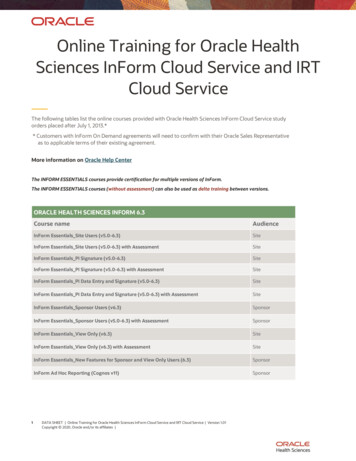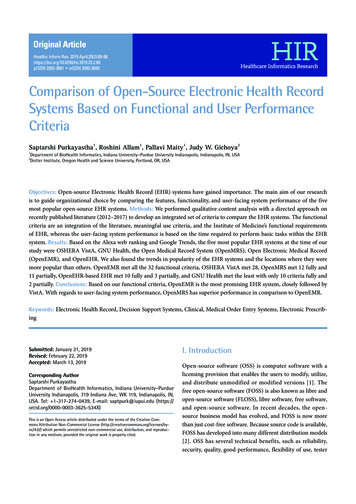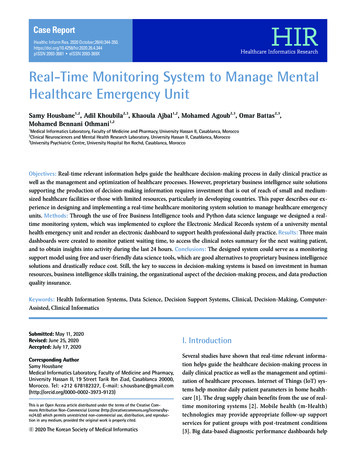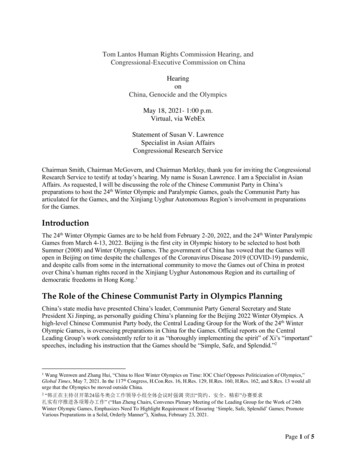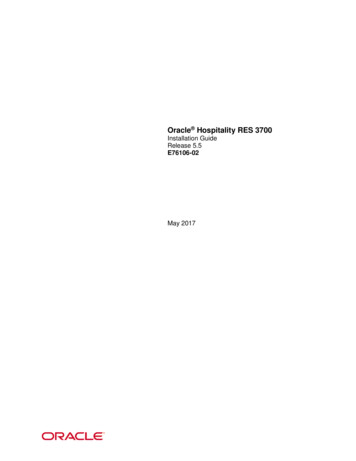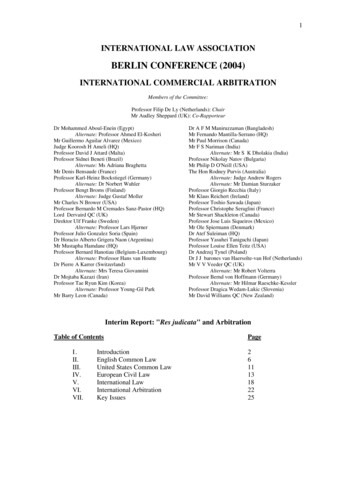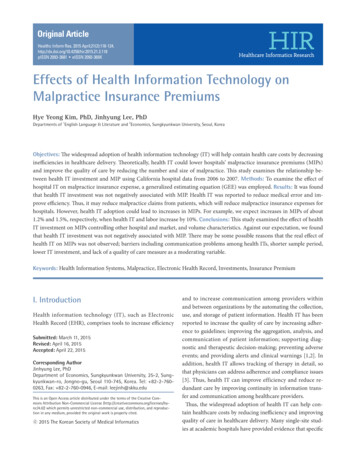
Transcription
Original ArticleHealthc Inform Res. 2015 2015.21.2.118pISSN 2093-3681 eISSN 2093-369XEffects of Health Information Technology onMalpractice Insurance PremiumsHye Yeong Kim, PhD, Jinhyung Lee, PhDDepartments of 1English Language & Literature and 2Economics, Sungkyunkwan University, Seoul, KoreaObjectives: The widespread adoption of health information technology (IT) will help contain health care costs by decreasinginefficiencies in healthcare delivery. Theoretically, health IT could lower hospitals’ malpractice insurance premiums (MIPs)and improve the quality of care by reducing the number and size of malpractice. This study examines the relationship between health IT investment and MIP using California hospital data from 2006 to 2007. Methods: To examine the effect ofhospital IT on malpractice insurance expense, a generalized estimating equation (GEE) was employed. Results: It was foundthat health IT investment was not negatively associated with MIP. Health IT was reported to reduce medical error and improve efficiency. Thus, it may reduce malpractice claims from patients, which will reduce malpractice insurance expenses forhospitals. However, health IT adoption could lead to increases in MIPs. For example, we expect increases in MIPs of about1.2% and 1.5%, respectively, when health IT and labor increase by 10%. Conclusions: This study examined the effect of healthIT investment on MIPs controlling other hospital and market, and volume characteristics. Against our expectation, we foundthat health IT investment was not negatively associated with MIP. There may be some possible reasons that the real effect ofhealth IT on MIPs was not observed; barriers including communication problems among health ITs, shorter sample period,lower IT investment, and lack of a quality of care measure as a moderating variable.Keywords: Health Information Systems, Malpractice, Electronic Health Record, Investments, Insurance PremiumI. IntroductionHealth information technology (IT), such as ElectronicHealth Record (EHR), comprises tools to increase efficiencySubmitted: March 11, 2015Revised: April 16, 2015Accepted: April 22, 2015Corresponding AuthorJinhyung Lee, PhDDepartment of Economics, Sungkyunkwan University, 25-2, Sungkyunkwan-ro, Jongno-gu, Seoul 110-745, Korea. Tel: 82-2-7600263, Fax: 82-2-760-0946, E-mail: leejinh@skku.eduThis is an Open Access article distributed under the terms of the Creative Commons Attribution Non-Commercial License (http://creativecommons.org/licenses/bync/4.0/) which permits unrestricted non-commercial use, distribution, and reproduction in any medium, provided the original work is properly cited. 2015 The Korean Society of Medical Informaticsand to increase communication among providers withinand between organizations by the automating the collection,use, and storage of patient information. Health IT has beenreported to increase the quality of care by increasing adherence to guidelines; improving the aggregation, analysis, andcommunication of patient information; supporting diagnostic and therapeutic decision-making; preventing adverseevents; and providing alerts and clinical warnings [1,2]. Inaddition, health IT allows tracking of therapy in detail, sothat physicians can address adherence and compliance issues[3]. Thus, health IT can improve efficiency and reduce redundant care by improving continuity in information transfer and communication among healthcare providers.Thus, the widespread adoption of health IT can help contain healthcare costs by reducing inefficiency and improvingquality of care in healthcare delivery. Many single-site studies at academic hospitals have provided evidence that specific
Effects of Health IT on Malpractice Insurance Premiumsfunctions of the Electronic Medical Record (EMR), includingclinical decision support or computerized physician order entry, may improve quality by reducing errors [4-6]. Other studies with large samples of hospitals have found evidence thatoverall spending on health IT is associated with improvedpatient safety, higher quality of care, and reduced costs [1,710]. Moreover, the Institute of Medicine (IOM) has encouraged adopting EMR to reduce medical errors and healthcarecosts, and the American Recovery and Reinvestment Act of2009 established financial incentives for hospitals to promotethe adoption and meaningful use of health IT.Accordingly, theoretically, health IT could improve qualityof care by reducing the number and size of malpractice casesand eventually lower hospitals’ malpractice insurance premiums (MIPs). According to the Certification Commission forHealthcare Information Technology (CCHIT), if a hospitalcan demonstrate to malpractice insurers that it has institutedappropriate technologies and processes, a malpractice insurer assumes the financial risk with the expectation that a hospital’s investment in technologies and processes will enable1) the hospital to avoid mistakes and intercept errors beforethey harm patients and 2) the insurer to obtain electronicrecords and seek the cause when an error occur [11]. Also,CCHIT asserted that the adoption of health IT may improvedefense against liability claims by improving medical recorddocumentation. If the insurer is better prepared to defendthe case through health IT, the results of settlement negotiations and jury trials may be more favorable to them.Hospitals may receive further discounts in MIPs in the future by providing demonstrable high quality patient care [12].Actually, some hospitals have had discounted MIPs becauseof the adoption of EMR [13-15]. These studies examined theeffect of health IT investment on MIP. It appears that somemalpractice insurers think that the use of health IT will decrease malpractice claims. Thus, they offer the discount forpolicy holders who have adopted health IT.Thus, a hospital’s adoption of health IT and an insurer’spremium are influenced by the expected benefits fromhealth IT when determining an MIP. Both of them expectthat health IT will monitor, control, and reduce informationasymmetry between clinicians and the hospital and betweenthe hospital and the insurer; health IT may reduce MIPsthrough improving quality of care and reducing medical errors in hospitals. However, to the best of our knowledge, noresearchers have examined the impact of health IT on futurequality of patient care measured by MIP. Therefore, thisstudy examined the relationship between health IT investment and MIP using California hospital data from 2006 to2007.Vol. 21 No. 2 April 2015II. Methods1. Data SourceThe hospital financial data in the Office of Statewide HealthPlanning and Development (OSHPD) and annual surveyof hospital by American Hospital Association (AHA) datawere utilized in this study. The OSHPD’s hospital financialdata include hospital characteristics, patient utilization, andfinancial information, including balance sheets, incomestatements, cash flow, etc. In the OSHPD, individual hospital financial disclosure reports are available beginning withreporting periods ending in 2002, The data are updatedcontinuously, and they include reports as originally submitted by each hospital and as desk audited by the OSHPD. Theoverall sample size was 483.These hospital financial data have been used in manyhealthcare and economic studies [2,16,17]. The AHA dataprofiles more than 6,500 hospitals throughout the UnitedStates. The response rate for the AHA annual survey hasbeen more than 70% each year. The survey is conducted tomaximize accuracy and participation (see detailed processin http://www.ahadataviewer.com/about/data/). AHA dataare used by government agencies, media, and the industryfor accurate and timely analysis and decision-making. Thisdatabase contains hospital-specific data on hospitals andhealthcare systems (except federal government hospitals), including organization location, size, structure, personnel, andhospital. For this study, acute care hospitals observed in twoconsecutive years were included. Two-hundred acute carehospitals were included for each year from 2006 to 2007, sothe final sample size was 400 overall.2. Dependent VariableThe dependent variable was the MIP defined as the cost incurred related to professional liability insurance and the costof self-insurance that has been actuarially determined. Thisinformation could be observed in the ‘trial balance worksheet and supplemental expense’ of the California hospitalfinancial data.3. Independent VariablesThree groups of variables were employed: 1) hospital andmarket characteristics, 2) the volume of hospital service, and3) health IT. Hospital characteristics included hospital andmarket characteristics, such as ownership, teaching status,number of beds, network hospital status, competition, andcase mix index (CMI). Hospital ownership was measuredby two dummy variables, namely, not-for-profit and government, with for-profit hospitals representing the reference.www.e-hir.org119
Hye Yeong Kim and Jinhyung LeeTeaching status was a dummy variable indicating Council ofTeaching Hospitals (COTH) membership. Beds were categorized into five specialized types of beds, including generalacute beds for adults, pediatrics, obstetrics, cardiac intensivecare, and neonatal intensive care. A network hospital wasrepresented by a dummy variable entitled system membership. To measure the competitiveness of a given geographicalmarket based on health service area (HSA), each hospital’sshare of adjusted admissions were calculated by summingthe total admissions and outpatient visits for each hospital[18]. Then, the share of adjusted admissions for each hospital for each HSA was calculated. Lastly, this share of adjustedadmission was squared and summed by HSA to obtain market competition or the Herfindahl-Hirschman Index (HHI).The HHI is an economic concept widely used as to measurecompetition [19-22]. The CMI is a measure of the relative resources needed to treat the mix of patients in each Californiahospital during a given calendar year. The OSHPD utilizesMedicare Severity-Diagnosis Related Groups (MS-DRG) tocalculate the CMI, and their associated weights, assignedto each MS-DRG by the Centers for Medicare & MedicaidServices (CMS). Then, each record is assigned an MS-DRGaccounting for principal and secondary diagnoses, age,procedures performed, the presence of comorbidities and/or complications, discharge status, and gender. Lastly, theOSHPD applies them to all patient discharge data during thecourse of a calendar year [23]. Volume includes total admissions, outpatient visits, percentage of Medicare and Medicaidadmissions out of total admissions, emergency room (ER)visits, and the numbers of inpatient and outpatient surgicaloperations. Lastly, our key independent variables were healthIT investment measured as IT capital as well as IT labor[2,16]. The OSHPD data places all IT expenditures withinthe data processing section of financial statements. Health ITcapital and IT labor were extracted from each hospital’s balance sheet. While health IT capital includes physical capital,purchased service, lease and rental and other direct expenditure, IT labor includes salaries and wages, employee benefits,and professional fees.4. Statistical AnalysisTo examine the effect of health IT on MIPs, a GEE was employed, which is used in many health care studies. The GEEcan control variance structure and clustering error withinhospitals. For the model selection, we tested quasi-likelihoodunder the independence model criterion (QIC) and chosethe independent variance model with the smallest QICamong many possible variance structures [24]. The regression model is expressed as120www.e-hir.orgMIPijt αi β1HCijt β2Volumeijt β3ITijt θ year Єijt,where MIP represents malpractice insurance premium.HC represents hospital and market characteristic vectorincluding hospital ownership (for-profit, not-for-profit, andgovernment hospitals), teaching status (COTH member),specialized number of beds (general acute beds for adults,pediatrics, obstetrics, cardiac intensive care, and neonatal intensive care), network hospital status, competition measuredby HHI, and CMI. Volume represents the patient utilizationvector, including total admissions, outpatient visits, percentage of Medicare and Medicaid ER visits, and numbers ofinpatient and outpatient surgical operations. IT includes ITcapital and IT labor investment. We took a log in MIP andIT investment because log transformations make skeweddistribution more normal. Year represents dummies for 2007years. All analyses were conducted using STATA ver. 11.2(STATA Corp., College Station, TX, USA).III. ResultsTable 1 shows descriptive statistics. Not-for-profit hospitalownership accounted for 55.3%. Teaching hospitals accountfor only 7% of the total sample. The numbers of beds variedaccording to type; the number of general acute care bedswas 103, general acute for pediatrics was 6.6, obstetrics 16.5,cardiac intensive care 4.5, and neonatal intensive care 7.6.Network hospitals accounted for 18.5%. Competition measured as HHI was 64.6%, and CMI was just over 1. The volume of outpatient visits was the largest compared to the totaladmissions and ER visits. The percentages of Medicare andMedicaid admissions were 44.2% and 24.8%, respectively.The number of surgeries during outpatient visits was almost1.2 times larger than that during inpatient visits. Health ITcapital investment was much larger than that of IT labor; 8.7 million for IT capital and 2.3 million for IT labor. Last,MIP was 1.8 million.Table 2 shows the GEE regression results. As seen in thetable, health IT capital and IT labor investment were positively associated with MIP in model 1. For example, we expect about 1.2% and 1.5% increases in MIP when health ITand labor increase by 10%, respectively. Moreover, we foundother significant variables related to MIP. Ownership playsan important role. Not-for-profit and government hospitalstatuses were negatively associated with MIP. Also, the typesof beds are important factors in determining MIP. For example, general acute beds for adults had a small but significantimpact on MIP. However, beds for general acute, pediatrics,cardiac intensive care, and neonatal intensive care were neghttp://dx.doi.org/10.4258/hir.2015.21.2.118
Effects of Health IT on Malpractice Insurance PremiumsIV. DiscussionTable 1. Descriptive profit44 (22.0)111 (56.5)Government45 (22.5)Teaching hospital(7.0)Number of bedsGeneral acuteGeneral acute for pediatricsObstetrics103.1 100.36.6 12.716.5 18.4Cardiac intensive care4.6 6.9Neonatal intensive care7.6 13.6Network hospital(18.5)HHI (competition)(64.4)Case Mix Index1.11Total admission10,370 8,223Outpatient visit147,375 164,082ER visit31,902 21,897% of Medicare(44.2)% of Medicaid(24.8)Surgery inpatient2,976 2,853Surgery outpatient3,708 3,060Health IT investment (million dollar)Capital8.7 16Labor2.3 4.2MIP1.8 2.3Number of hospitals200Values are presented as number (%) or mean standard deviation.HHI: Herfindahl-Hirschman Index.atively associated with MIP. We also found that higher competition and lower CMI led to higher MIP. Hospital volumesincluding total admissions, outpatient visits, and ER visits,were positively associated with MIP as expected. However,the percentage of Medicare admissions led to lower MIP.Also, the number of surgical inpatient visits was associatedwith higher MIP.As shown in the second column (mode 2) of Table 2, wemeasured the lagged health IT investment on MIP becausehealth IT could be effective by learning by doing [8]. However, we also found that health IT capital and IT labor werepositively associated with MIP. Other variables showed similar relationships with MIP as in model 1.Vol. 21 No. 2 April 2015This study examined the effect of health IT investment onMIP controlling other hospital, market, and volume characteristics. It appears that some malpractice insurers think thatthe use of health IT will decrease malpractice claims. Thus,they offer discounts to policy holders who have adoptedhealth IT systems, such as EMR. For example, policyholdersin Texas who documented EMR use for at least one year canhave their MIPs discounted by 2.5% [13]. Also, providersthat have implemented certified EMR in the Midwest canqualify for credit of between 2% and 5% from their medical insurance company [14]. Blue Cross and Blue Shield ofNew Jersey offer premium discounts to providers who haveimplemented approved EMR systems [15].However, contrary to previous expectations, this studyfound that health IT investment was positively associatedwith MIP. There may be four possible explanations. First,there are many barriers of health IT investment [25-27]. Forexample, physicians have workflow disruption; they may nothave enough time to become familiar with health IT andtrain to use it. Also, other barriers were listed as concernsabout security and privacy, complexity in the documentingprocess, and lack of computer skills, among others. In addition, communication may be an important barrier. HealthIT systems, including EMR and computerized patient orderentry (CPOE), may not communicate with each other, although they are intended to prevent medical errors and improve patient outcomes. Some previous studies also doubtedthe effect of EMR on the risk of being sued because mostEMR charts are template-driven. Also, current EMR systemsare not able to communicate with one another. Thus, superfluous or inaccurate information may often creep into a documented patient visit [28]. Also, several lawyers have arguedthat the default settings of an EMR could present almost noopportunities for physicians to add information to medicalrecords. Also, EMR could provide too much information.For instance, the risk of being sued may increase if an EMRprovides too many alerts or warnings that physicians do notrespond to. Thus, these kinds of barrier may prevent healthIT from being effective.Second, our sample only covered a short duration of twoyears, so it may not reflect the real effect of health IT investment on MIP; some studies found that health IT could beeffective 3 to 5 years after adoption [2,8,16,18].Third, lower health IT investment may not be effective inreducing MIP. For example, Victoroff et al. [29] evaluate theeffect of EHR use on medical liability claims in a populationof office-based physicians, including claims that could powww.e-hir.org121
Hye Yeong Kim and Jinhyung LeeTable 2. Results of generalized estimating equation regression parametersVariableModel 1Model 2CoefficientSECoefficientSE----OwnershipFor-profit .0860.096c0.110c0.131-0.723-0.574Teaching statueNon-teaching (reference)Teaching-----0.0800.0870.0260.115Number of bedsGeneral acute for .002General acute for pediatrics-0.008Obstetrics-0.002Cardiac intensive careNeonatal intensive 040.003Network statueNo network (reference)Network -0.131a-0.394b0.157-0.3670.201Total admission (per 1,000 patients)0.022c0.0070.0150.010Outpatient visit (per 1,000 patients)0.001c0.0000.0000.0000.006c-1.413cHHI (competition)Case Mix IndexaVolumeER visit (per 1,000 patients)% of Medicare% of 110.117c0.037----0.143c0.0490.146c0.026--Surgery inpatient (per 1,000 patients)0.084Surgery outpatient (per 1,000 patients)Information technologyLog IT capitalLog IT capital (t-1)Log IT laborLog IT labor g IT capital (t-1) represents one time lagged value Log IT capital; Log IT labor (t-1) represents one time lagged value Log IT labor.HHI: Herfindahl-Hirschman Index, ER: emergency room.ap 0.1, bp 0.05, cp 0.01.tentially be directly prevented by features available in EHRs.They argued that the lack of significant effect may be due toa low prevalence of EHR-sensitive claims. Similarly, in oursample, the health IT capital investment was just around5% out of total revenue. Compared to other IT industries(around 9%), this ratio is too low. Thus, this lower IT in122www.e-hir.orgvestment may not lead to reduced MIP. Another concernis that health IT investment may lead to a larger number ofmalpractice suits because patients may have more scientificevidence for them. However, in the current stage of health ITadoption in the years of 2006 and 2007, only a small number of hospitals had adopted EMR systems, and the amounthttp://dx.doi.org/10.4258/hir.2015.21.2.118
Effects of Health IT on Malpractice Insurance Premiumsof health IT investment was low in each hospital [2]. Thus,this concern may not apply to the current stage of health ITinvestment. However, this argument may be applicable formore recent data.Lastly, the quality of care could be a moderating variablein this analysis. For example, the quality of care may reduceMIP but health IT investment may have a direct effect. Thus,the lack of quality of care measurement in the analysis mayhave led to biased estimates.Even though we could not find a negative relationship between health IT and MIP as expected, it was the first study toexamine the effect of health IT investment on MIP at a hospital level. Unlike physicians, hospitals’ MIPs are based onthe experience rating. Thus, if a hospitals’ claims experienceis more stable over time after more health IT investment, theMIP related to the hospital will be reduced.In conclusion, we examined the effect of health IT on quality of care measured by MIPs using two years of Californiahospital data and found that health IT was not negatively associated with MIP. There may be three possible limitations ofthis study such that the real effect of health IT on MIPs maynot have been observed, including communication problemsamong health ITs, the short sample period, and low IT investment.The study results imply that the hospital managers andinsurers should be cautious to interpret the effect of healthIT on MIP and that they should remember that EMR adoption itself may not lead to improved quality of care or reduceMIP. Instead, it could increase MIP by worsening the qualityof care without working with IT vendors and physicians atthe same time of EMR adoption.Conflict of Interest5.6.7.8.9.10.11.12.13.No potential conflict of interest relevant to this article wasreported.References1. Parente ST, McCullough JS. Health information technology and patient safety: evidence from panel data. HealthAff (Millwood) 2009;28(2):357-60.2. Lee J, McCullough JS, Town RJ. The impact of healthinformation technology on hospital productivity. Rand JEcon 2013;44(3):545-68.3. Institute of Medicine. Crossing the quality chasm: a newhealth system for the 21st century. Washington (DC):National Academies Press; 2001.4. Kuperman GJ, Gibson RF. Computer physician orderVol. 21 No. 2 April 201514.15.entry: benefits, costs, and issues. Ann Intern Med 2003;139(1):31-9.Garg AX, Adhikari NK, McDonald H, Rosas-ArellanoMP, Devereaux PJ, Beyene J, et al. Effects of computerized clinical decision support systems on practitionerperformance and patient outcomes: a systematic review.JAMA 2005;293(10):1223-38.Chaudhry B, Wang J, Wu S, Maglione M, Mojica W,Roth E, et al. Systematic review: impact of health information technology on quality, efficiency, and costs ofmedical care. Ann Intern Med 2006;144(10):742-52.Parente ST, Van Horn RL. Valuing hospital investmentin information technology: does governance make a difference? Health Care Financ Rev 2006;28(2):31-43.Borzekowski R. Measuring the cost impact of hospitalinformation systems: 1987-1994. J Health Econ 2009;28(5):938-49.Yu FB, Menachemi N, Berner ES, Allison JJ, WeissmanNW, Houston TK. Full implementation of computerizedphysician order entry and medication-related qualityoutcomes: a study of 3364 hospitals. Am J Med Qual2009;24(4):278-86.Himmelstein DU, Wright A, Woolhandler S. Hospitalcomputing and the costs and quality of care: a nationalstudy. Am J Med 2010;123(1):40-6.Certification Commission for Healthcare InformationTechnology. CCHIT certified electronic health recordsreduce malpractice risk. [place unknown]: CertificationCommission for Healthcare Information Technology;2007.Sloan FA, Shadle JH. Is there empirical evidence for“Defensive Medicine”? A reassessment. J Health Econ2009;28(2):481-91.Texas Medical Association. EMR implementation guide– online course instruction [Internet]. Austin (TX):Texas Medical Association; c2013 [cited at 2015 Apr15]. Available from: http://www.texmed.org/Template.aspx?id 6188.MMIC Group. The Certified Electronic Medical RecordRisk Management Premium Credit [Internet]. Minneapolis (MN): MMIC Group; 2014 [cited at 2015 Apr15]. Available from: http://mmicgroup.com/pdf/EHRApplication.pdfKing P. Can electronic medical records help to decreasemalpractice insurance costs? [Internet]. [place unknown]: netdoc.com; 2010 [cited at 2015 Apr 15]. Available from: rds-Help-to-Decrease-Malpracticewww.e-hir.org123
Hye Yeong Kim and Jinhyung LeeInsurance-Costs?/.16. Lee J, Dowd B. Effect of health information technologyexpenditure on patient level cost. Healthc Inform Res2013;19(3):215-21.17. Reiter KL, Song PH. The role of financial market performance in hospital capital investment. J Health CareFinance 2011;37(3):38-50.18. McCullough JS. The adoption of hospital informationsystems. Health Econ 2008;17(5):649-64.19. Gowrisankaran G, Town RJ. Estimating the quality ofcare in hospitals using instrumental variables. J HealthEcon 1999;18(6):747-67.20. Lave JR, Pashos CL, Anderson GF, Brailer D, Bubolz T,Conrad D, et al. Costing medical care: using Medicareadministrative data. Med Care 1994;32(7 Suppl):JS77-89.21. Hayes KJ, Pettengill J, Stensland J. Getting the priceright: Medicare payment rates for cardiovascular services. Health Aff (Millwood) 2007;26(1):124-36.22. Gapenski LC. Healthcare finance: an introduction toaccounting and financial management. 5th ed. Chicago(IL): Health Administration Press; 2012.23. Office of Statewide Health Planning & Development.Case Mix Index [Internet]. Sacramento (CA): Officeof Statewide Health Planning & Development, State ofCalifornia; 2014 [cited at 2015 Apr 15]. Available Index/.Cui J. QIC program and model selection in GEE analyses. Stata J 2007;7(2):209-20.Boonstra A, Broekhuis M. Barriers to the acceptance ofelectronic medical records by physicians from systematic review to taxonomy and interventions. BMC HealthServ Res 2010;10:231.DesRoches CM, Campbell EG, Rao SR, Donelan K, Ferris TG, Jha A, et al. Electronic health records in ambulatory care--a national survey of physicians. N Engl J Med2008;359(1):50-60.Vishwanath A, Scamurra SD. Barriers to the adoptionof electronic health records: using concept mapping todevelop a comprehensive empirical model. Health Informatics J 2007;13(2):119-34.KevinMD. Do electronic medical records decrease liability risk? [Internet]. [place unknown]: KevinMD.com; 2009 [cited at 2015 Apr 15]. Available from: icalrecords-decrease-liability-risk.html.Victoroff MS, Drury BM, Campagna EJ, Morrato EH.Impact of electronic health records on malpractice claimsin a sample of physician offices in Colorado: a retrospective cohort study. J Gen Intern Med 15.21.2.118
hospitals. However, health IT adoption could lead to increases in MIPs. For example, we expect increases in MIPs of about 1.2% and 1.5%, respectively, when health IT and labor increase by 10%. Conclusions: This study examined the effect of health IT investment on MIPs controlling other hospital and market, and volume characteristics.
